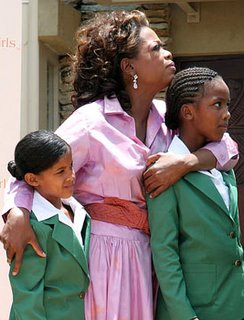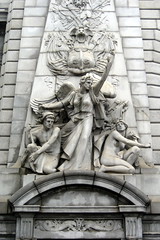Sunday, August 19, 2007
Hurricane Dean news from Kingston
Sunday, August 19, 2007, 9:00 am
By fwade - moving back to ja
In an hour or so (10am Jamaica time) we are supposed to lose power -- an intentional shut down for safety reasons. There is also a 48 hour curfew that is in place. So you might not be hearing from this part of the world in a few minutes, for what could be a while. What we will have is decent cell phone coverage, however. So, here we are, sitting and watching and waiting for Dean...
Power 106 News - Dean tracking south
Sunday, August 19, 2007 at 1 pm
From go-jamaica : storm news
The Meteorological Services of Jamaica is reporting that Hurricane Dean is now located 90 miles south east of Morant Point. Duty Forecaster at the Met Office Viola Jones says the system remains a powerful category 4 system. Meanwhile meteorologists from the weather channel say the system could be very destructive.
Thursday, July 05, 2007
Bloglines - Incremental infrastructure, or how mobile phones might wire Africa
Does the expansion of cell phone use in countries like Jamaica offer any insights into development strategies more generally? Power blogger Ethan Zuckerman shares his thoughts. Mike
| |||||
|
Saturday, June 16, 2007
how do you get there? Cunha Cunha Pass Trail
Ms. Wilks has been involved in youth development activities in Kingston for many years, and spends her 'retirement' in Millbank (although there is nothing retiring about Linette!) If you are driving up the valley of the Rio Grande River from Port Antonia the eco-tourist cabins are a few miles past Millbank. I must warn you, however: that road from Port Antonio is notorious and brutal, particularly in the rainy season. David Kingsley has only driven it once, and will not drive it again. We hear various reports from others about its current condition.
If you wish to visit the Ambassabeth Cottages, send Ms. Wilks a call well in advance (876 395-5351; ask her for her email address as backup). She can arrange for a trail guide to meet you in Hayfield for the hike over. The guide books say that she can also arrange to pick you up in Port Antonio or Kingston. The farmers of Bowden Pen say the hike is five and a half miles, but it seems longer. If you are going to hike over, you might as well stay overnight, prepare for rain, and bring repellent with DEET. We left mosquito netting at Ambassabeth, so perhaps you will be able to us it! The accommodations are substantial (albeit rustic), the food is wonderful, and the mornings are exquisite - the best time to go out on hikes, before the rain sets in.
While I was taking the trail photos and meeting my wife in Hayfield on Sunday morning, the six Temple University study abroad students were visiting the Quaco River with an expert guide. I'm hoping they will share their digital photos, and that I can share one or two of them here.
Tuesday, June 12, 2007
Jamaican news

KINGSTON (JIS)
He said that as Jamaicans, "it is only fitting that we seek to commemorate this historic occasion and to heighten consciousness throughout the island about the transatlantic slave trade and its abolition 200 years ago", noting that estimates indicate that Jamaica accounted for approximately 1 million of the 15 million Africans forcefully brought to this part of the world during the period of slavery.
Friday, January 05, 2007
Oprah's Leadership School for South African Girls
 U.S. talk show queen Oprah Winfrey, right, shares a podium with former South African President Nelson Mandela, left, as students look on, during the official opening of Winfrey's Leadership Academy for Girls School at Henley-on-Klip, South Africa, Tuesday, Jan. 2, 2007....
U.S. talk show queen Oprah Winfrey, right, shares a podium with former South African President Nelson Mandela, left, as students look on, during the official opening of Winfrey's Leadership Academy for Girls School at Henley-on-Klip, South Africa, Tuesday, Jan. 2, 2007....(photo supplied by Harpo Productions Inc.)
This school, located in Midvaal Local Municipality southeast of Johannesburg (Gauteng Province), has generated equal amounts of acclaim and criticism in the blog world. Only time will tell, but no doubt the impact of the school will be immense. Oprah has fully committed to the project -- some are writing about the amount spent per student (over quarter million US dollars) but Oprah is clearly designing the school and shifting her own commitments for the long term. Time will tell - we want to know more about the teachers as well as the curriculum. It is very clear that this is a school for the elite, with only 4% of the applicants accepted in the first year.
In this way, the project presents a striking contast to the Baraka School, profiled in the excellent POV documentary "The Boys of Baraka." The initiative, proposed by the Baltimore Public Schools to the Abell Foundation back in 1996, offered to a select group of struggling Baltimore youth the chance to spend their middle school years at an alternative placement in rural Kenya. The article "Blessings from the Dark Continent: The Baraka School," The Black Perspective Online, offers an account of the back-to-basics approach.
Nestled on 150 acres, Baraka's campus has three horses, vegetable gardens and fruit trees. Students wear uniforms and live dorm-style, three to a room, in traditional African round houses with thatched roofs. Solar energy provides the power, and electricity is available only 6 hours a day. Nanyuki, reminiscent of the small towns of America's old west, is closest, approximately 45 minutes away on dirt roads, Nanyuki has a handful of restaurants, one hardware store and two hotels.The Baraka School initiative fell victim to terror threats following the September 11, 2001 attacks. Worried about increased costs and the wellbeing of the youth in Kenya, the Abell Foundation pulled their funding. The documentary follows the lives of students expected to be able to benefit from two years at Baraka, only to learn that they would have to go back to mediocre Baltimore public schools after only one (intense) year in Kenya. For some of the youth, that one year was a great assist and they were able to find a place for themselves in their communities and in higher education. Others became demoralized and at last check-in with the filmmakers were still struggling. Students viewing this film have really felt for the boys and their families. Check out these sample comments from students to an article about the documentary in Baltimore's City Paper.
Adopting the philosophy that a change in outlook and improvements in performance can take place in Baltimore without having to resort to the African sojourn, other philanthropic foundations have invested in new schooling models. Check out KIPP Ujima Village on Greenspring Avenue in Northeast Baltimore. FYI: KIPP Schools, supported Fisher Foundation, have also been getting a good deal of attention from Oprah, Michael J. Petrilli of the Hoover Institution's Education Next Magazine, and from Jay Mathews, the education reporter for the Washington Post.
In the recent spate of stories about the opening Oprah's new African leadership school, we see a hands-on approach that is gratifying (in comparison to the abandonment of the Baraka experiment) but also a little over the top. I believe that Oprah views her project as the entry point for a far more massive intervention into South African, and African society more generally. As Marc Hill notes in his Barbershop Notebooks Blog, Oprah apparently feels a far more profound bond to African youth than to struggling African-Americans in urban Baltimore and Philadelphia who, in response to her question "What do you want or need" will say "an iPod or some sneakers." Oprah Winfrey plans to nest at Henley-on-Klip, building her own house on the property so she
 can keep a close eye on the school as it develops and evolves with time.
can keep a close eye on the school as it develops and evolves with time.Read on for a few of the myriad accounts and opinions:
Wednesday, January 03, 2007
Upcoming trip to NYC - Chinatown and the LESTM

NYC - Chinatown: Manhattan Bridge Arch - Spirit of Commerce
Originally uploaded by wallyg.
I am looking forward to my trip to New York next weekend. Margot and Chris live in Brooklyn, and we are going to meet up earlier in the day to visit the Lower East Side Tenement Museum (LESTM). This is a really great social history museum that profiles the experiences of families that immigrated to the United States around the turn of the twentieth century. My goal for the afternoon is to learn some interesting facts and discuss strategies for teaching this immigration history so that it comes alive for the my Temple University students, many of whom are already from immigrant families.
I am already getting excited about the trip, and have been enjoying a virtual visit of the neigbhorhood. Wally G. has posted on Flickr a wonderful collection of photos taken from the mean streets of the Lower East Side and Chinatown. This photos, can be explored using Google Maps, allowing the user to map out their own itinerary. *Click* on the photo above, then *click* on the "map" link on the lower right in order to explore his collection in plan view!
Later that evening, we will all be attendng the reunion concert of the dB's and the Sneakers at the Bowery Ballroom. Sounds like fun, although I still haven't learned how to take satisfying concert pictures so you are just going to have to imagine the scene. Mike
